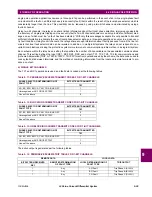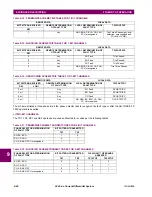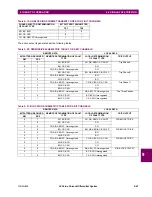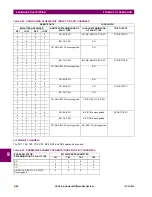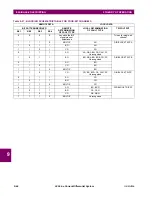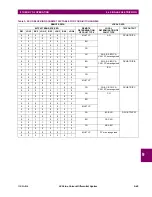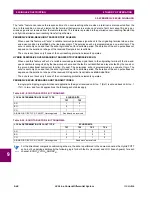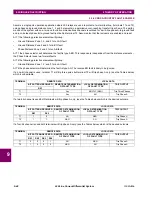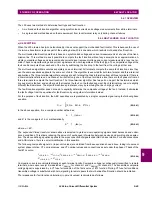
GE Multilin
L90 Line Current Differential System
9-37
9 THEORY OF OPERATION
9.5 SINGLE-POLE TRIPPING
9
9.5.2 PHASE SELECTION
The L90 uses phase relations between current symmetrical components for phase selection. First, the algorithm validates if
there is enough zero-sequence, positive-sequence, and negative-sequence currents for reliable analysis. The comparison
is adaptive; that is, the magnitudes of the three symmetrical components used mutually as restraints confirm if a given com-
ponent is large enough to be used for phase selection. Once the current magnitudes are validated, the algorithm analyzes
phase relations between the negative-sequence and positive-sequence currents and negative-sequence and zero-
sequence currents (when applicable) as illustrated below.
Figure 9–14: PHASE SELECTION PRINCIPLE (ABC PHASE ROTATION)
Due to dual comparisons, the algorithm is very secure. For increased accuracy and to facilitate operation in weak systems,
the pre-fault components are removed from the analyzed currents. The algorithm is very fast and ensures proper phase
selection before any of the correctly set protection elements operates.
Under unusual circumstances such as weak-infeed conditions with the zero-sequence current dominating during any
ground fault, or during cross-country faults, the current-based phase selector may not recognize any of the known fault pat-
tern. If this is the case, voltages are used for phase selection. The voltage algorithm is the same as the current-based algo-
rithm; for example, phase angles between the zero-sequence, negative-sequence, and positive-sequence voltages are
used. The pre-fault values are subtracted prior to any calculations.
The pre-fault quantities are captured and the calculations start when the disturbance detector (50DD) operates. When an
open pole is declared, the phase selector resets all its outputs operands and ignores any subsequent operations of the dis-
turbance detector.
The phase selector runs continuously. When there is no disturbance in the power system, and the disturbance detector
(50DD) from the source assigned as the
DISTANCE SOURCE
is reset, then the
PHASE SELECT VOID
FlexLogic operand is set
and all other phase selector operands are reset. All current and voltage sequence components are memorized and contin-
uously updated.
When the disturbance detector (50DD) operates, memory stops being updated and retains two cycles of old current and
voltage values. First, purely fault components of current and voltage are calculated by removing the pre-fault (memory)
quantities from presently calculated values. A series of conditions are checked with respect to magnitudes and phase
angles of current and voltage symmetrical components in order to detect the fault type. Secondly, currents are used to iden-
tify the fault type (AG, BG, CG, AB, BC, CA, ABG, BCG or CAG) according to the
Phase selection principle
figure above. If
the currents fail to identify the fault type, and voltages are available, then voltages are used. If any of the above types is
determined, then the corresponding FlexLogic operand below is asserted.
837725A1.CDR
AB,
ABG
CA,
CAG
BC,
BCG
AG
AG,
BCG
I
2F
I
2F
I
1F
I
0F
BG
CG,
ABG
CG
BG,
CAG
Summary of Contents for UR Series L90
Page 652: ...A 16 L90 Line Current Differential System GE Multilin A 1 PARAMETER LISTS APPENDIX A A ...
Page 772: ...B 120 L90 Line Current Differential System GE Multilin B 4 MEMORY MAPPING APPENDIX B B ...
Page 802: ...C 30 L90 Line Current Differential System GE Multilin C 7 LOGICAL NODES APPENDIX C C ...
Page 812: ...D 10 L90 Line Current Differential System GE Multilin D 1 IEC 60870 5 104 APPENDIX D D ...
Page 824: ...E 12 L90 Line Current Differential System GE Multilin E 2 DNP POINT LISTS APPENDIX E E ...
Page 834: ...F 10 L90 Line Current Differential System GE Multilin F 3 WARRANTY APPENDIX F F ...
Page 846: ...xii L90 Line Current Differential System GE Multilin INDEX ...

















